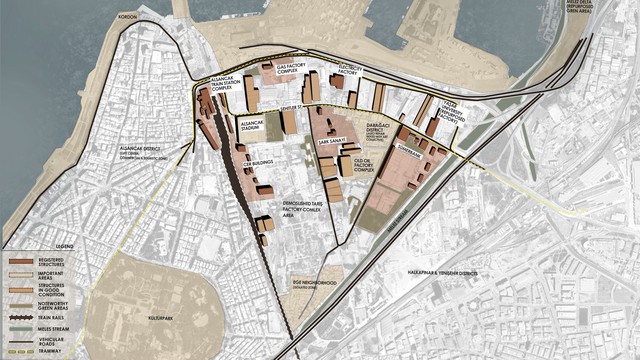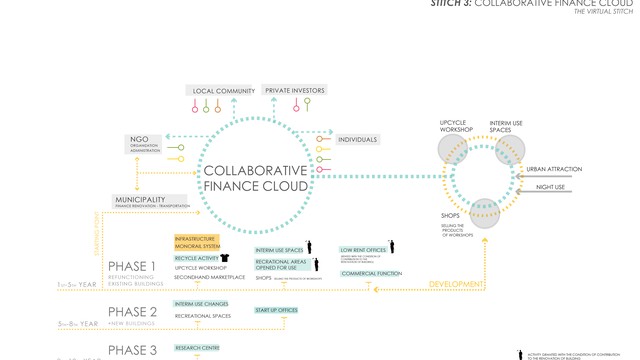Connecting Limanarkasi 2019, Turkey, Ankara
An Urban Experiment with the concept of Stitching






This project aims to develop an urban scenario for an abandoned industrial heritage site, Limanarkası, by integrating active forms of ‘grassroots urbanism’ and experimenting with the urban organizational concept of ‘stitching’. The Limanarkası district ,whose edges are occupied with boundaries preventing access, namely; a railway line, commercial harbor, and the Meles stream, is historically significant for the city of İzmir; it hosted the first examples of the New Republic's industrial structures such as Sumerbank, Taris complexes and contributed to the ‘port city’ identity of Izmir. Although most of the industrial heritage still exists; the area is largely abandoned. Given the central location of this area, the need for a reconnection to the city is undeniable and overdue. Having several different definitions in the literature, we interpreted urban stitching as ‘implementing physical and virtual strategies for enabling sustainable development of an unused site by restoring its connections with people and the city’.
There are three stitching strategies offered that complement each other. The first two are ‘physical stitches’, the other one is a ‘virtual stitch’. The first stitching strategy, ‘Physical Connections and Pedestrian Circulation’, consists of new public spaces and overpasses aiming to physically overcome the strongly defined boundaries around the site. The second physical stitching strategy is the Monorail Transportation System, which aims to catalyze the accessibility of the site from different parts of the city by its elevated infrastructure. The last one is a virtual stitching strategy, ‘Collaborative Finance Cloud’, which offers a new economic system designed as an active form to increase the attraction towards the site and contribute to its economic and physical development. The Collaborative Finance Cloud is a participatory system designed to work with ‘points’ to bring together all the parties of the site around the common goal of development and re-functioning of the site. Each party contributes to the system in a unique manner, this creates a coherent whole. The municipality finances or builds the transportation system, renovates the existing historical buildings and regulates the point system. NGO's are responsible for the organization and administration of the finance cloud as a neutral participant and protect the site from extensive privatization to avoid sharp increases in rent. Private investors finance the system and receive service in return. The point system of the Collaborative Finance Cloud is designed to attract local communities and individuals. If the participants show active participation in the renovation processes or provide materials for upcycling or recycling, they gain points stored in a mobile phone app which can be used for acquiring several services such as public transportation, office renting, or purchasing upcycled products. The app is not limited to point storage; it also works as a social media platform that allows participants to schedule or list events and state or discuss their opinions about all the services through written or visual posts and polls. Additionally, the app has an introduction game aiming to raise awareness about the significance of the site as well as offering a fun experience. All the historic buildings on the site are planned to be signed with a barcode reader using augmented reality. The visitors can reach information about the site or a specific building in the format of a story game, including their original functions, history, old photos or current activities taking place, and collecting hidden point packs around the site.
Details
Team members : Aslı Zeynep Doğan, Batuhan Gültaktı, Elif Saygın, Furkan Bora Kılıç, Meral Karakoyun
Supervisor : Prof. Dr. Zeynep Mennan Inst. Ayşin Sevgi Macit Inst. Ezgi İşbilen Res. Asst. Orçun Sena Saracoğlu
Institution : Middle East Technical University
Descriptions
Technical Concept : The refunctioning is planned as a three-phase process which gradually integrates the new functions that encourage urban attraction and night use in the site. The first phase is a five year period where the physical stitching strategies are implemented and first attempts at re-functioning start. The renovated buildings will be re-functioned as upcycle or recycle workshops, secondhand markets, low rent offices or for interim use. The second phase is a three-year period where new buildings are starting to be built such as start-up offices and new open recreational spaces are defined. The third phase is a two-year period where the site is developed and it will give back to society by incorporating a new function, scientific research, with the income generated through the collaborative finance cloud.
Visual Concept : The Limanarkası district is neighboring Alsancak district, a lively part of the city which includes cafes, public spaces, parks and serves as a potential area for stitching. On the opposite side, behind the Meles stream, there is a rapidly developing residential area which could potentially provide the site with 24 hr human activity after being stitched to the site. The scenario proposes to reclaim the industrial character of the site as a new place for ‘clean industries’. The clean industries can be exemplified as recycling of paper, electronic parts and textile. In conclusion, the proposed scenario aims to transform the site from a dead land stuck between its closed borders into a productive, sustainable and lively hub for social, cultural and scientific activities, without losing the historical significance and urban memory it has in the minds of İzmir's citizens.
Credits
Project Owners
Project Owners
Project Owners
Project Owners
Project Owners
Project Owners
Project Owners